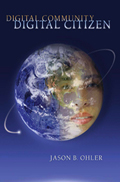Digital Storytelling in the Classroom now shipping! To find out more, go to the Corwin Press site.  The book begins with "Twenty Revelations about Digital Storytelling in Education." We are up to revelation 14. You are invited to visit previous journal entries to read the first thirteen.
The book begins with "Twenty Revelations about Digital Storytelling in Education." We are up to revelation 14. You are invited to visit previous journal entries to read the first thirteen.
 The book begins with "Twenty Revelations about Digital Storytelling in Education." We are up to revelation 14. You are invited to visit previous journal entries to read the first thirteen.
The book begins with "Twenty Revelations about Digital Storytelling in Education." We are up to revelation 14. You are invited to visit previous journal entries to read the first thirteen.Revelation #14: Combining storytelling and critical thinking defines an important pedagogical frontier
Book excerpt: "Story’s structure and rhythm, as well as the emotional involvement it encourages, can help us remember important information that might be forgotten if it is delivered to us in the form of reports, lectures, or isolated bits of information… But stories can be dangerous. Because engaging with stories demands that we ‘willingly suspend our disbelief’ (Coleridge, 1817), we let our guard down and tend to consume the story experience with little critical assessment...Clearly we need to blend the power and engagement of storytelling with the skills and perspective that insight and critical assessment offer.
----------------
How Ads Effect
Pierce and feed the neocortex simultaneously. The power of so many advertisements is their ability to pierce the neocortex, while feeding it at the same time. In other words, ads need to get past your critical mind to make an emotional connection with you subconscious, while at the same time giving you good reasons to buy something, should you need to justify your purchase to yourself or others. The following diagrams depicts this:

-> Click on the image to enlarge it.
----------------
New resources via jasonohler.com
- Beyond Essays: How we show what we know in the digital age. Being literate means being able to consume and produce the media forms of the day, what
 ever they might be. For centuries this has meant media consisting primarily of words. But today's media forms consist of a good deal more than words: images, sounds, music, video, and much more. Putting them together requires media literacy. Doing so with expertise requires media fluency. See the beyond essays website for more.
ever they might be. For centuries this has meant media consisting primarily of words. But today's media forms consist of a good deal more than words: images, sounds, music, video, and much more. Putting them together requires media literacy. Doing so with expertise requires media fluency. See the beyond essays website for more.
- Beyond Words: the Multimedia Collage, a keynote presentation built upon the material from the Beyond Essays website… described on keynote site.
- Visualization resources, about how images are being used to convey information that was once confined to text presentations… available at the visualization web site. Thanks to Mark Avnet.
----------------
TECHST MESSAGES... news bits from the tEcosystem...

New York Times’ Enters Distance Learning Market
What's an outdated media source to do? Repackage what it has into learning materials.
The New York Times on Thursday announced a major push into higher education — with new efforts to provide distance education, course content and social networking. A number of colleges are already either committed to using the new technologies or are in negotiations to start doing so, evidence of the strong power of the Times brand in academe.
read more...
--- -- ---
96 percent of teens use social-networking tools
No surprise there. But finally we have some statistics to back it up.
read more...
--- -- ---
Conference I wish I had attended: WIRED' NextFest 2007 Education Day
--- -- ---
This issue's neologism: mediast (MEE-DEE-ist). One who creates, produces or works with media for a living or on an on-going basis.
Usage: "Today's student is a mediast by default, using a number of media to create blogs, movies and other media forms." ... I forget who I said that to.
--- -- ---
New fear I have: Robots understanding my jokes. Well, at least someone…er, something…will. Check out the New Scientist article.
--- -- ---
Cool art website I'm checking out: Truck Art. Artists turn 2D into 3D, this time on trucks. Or at least it appears that way. Could well be an elaborate PhotoShop ruse. Either way, quite something to behold. Here's an example. To see a bunch more, look at the entire gallery.







